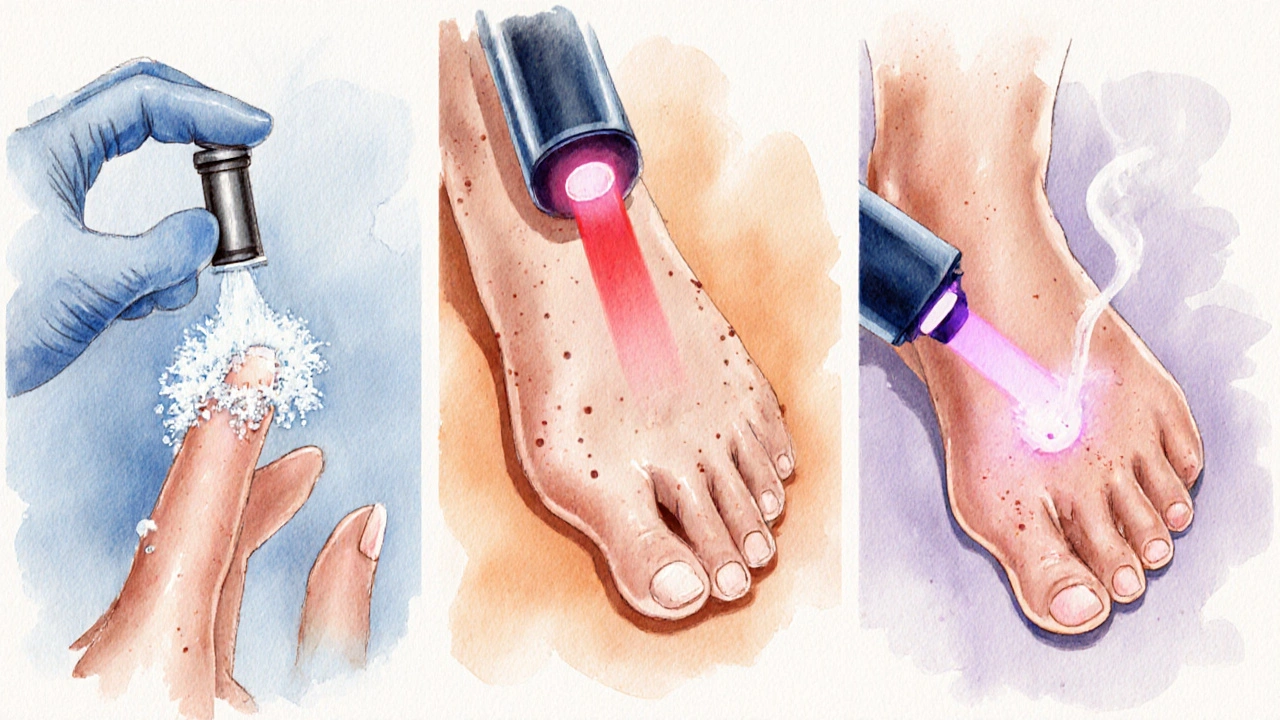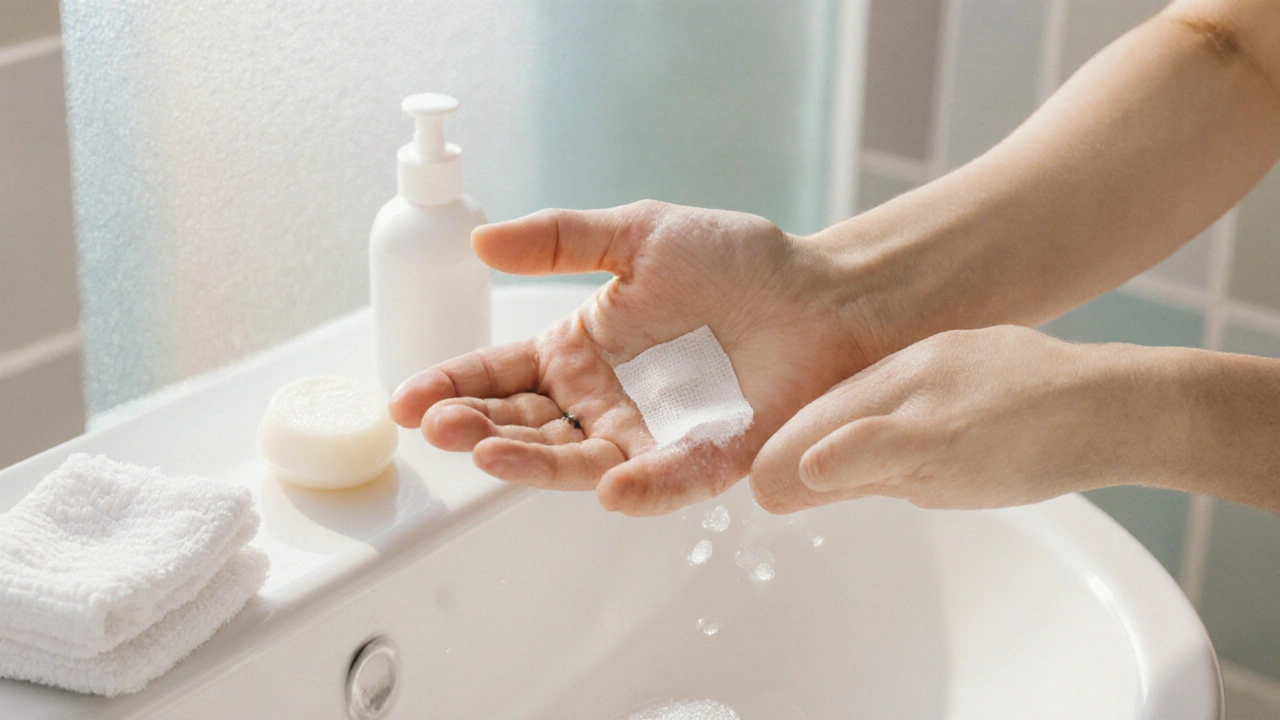Sun Protection Calculator for Wart Removal Recovery
How Much Sunscreen Do You Need?
Your Application Guide
Recommended Amount per Application
(Approximately 1/2 teaspoon)
Daily Application Frequency
(Reapply after swimming or sweating)
Just had a wart taken off? Your skin needs a little TLC to heal right, avoid infection, and keep scarring to a minimum. This guide walks you through everything you need to know-from the first hour after the procedure to the months that follow.
Quick Takeaways
- Keep the area clean and lightly covered for the first 24‑48hours.
- Apply a fragrance‑free moisturizer two to three times daily once the skin feels dry.
- Shield the spot with sunscreen (SPF30+) for at least six weeks.
- Watch for signs of infection-redness that spreads, increasing pain, or pus.
- Schedule a follow‑up with your Dermatologist if healing stalls or scars form.
Understanding Wart Removal
A Wart is a benign skin growth caused by the human papillomavirus (HPV). Most professionals remove warts using one of three main techniques:
- Cryotherapy - liquid nitrogen freezes the wart.
- Electrosurgery - an electric current burns it away.
- Laser therapy - focused light vaporizes the tissue.
Regardless of the method, the skin’s natural healing cascade is the same: inflammation, tissue formation, and remodeling. Your aftercare plan simply supports that process.
Immediate Post‑Procedure Care (First 24‑48 Hours)
- Gentle cleaning: Use lukewarm water and a mild, fragrance‑free soap. Pat dry with a clean towel-don’t rub.
- Protective dressing: Your clinician may apply a sterile gauze strip. Leave it on for the recommended time (usually 12‑24hours) unless instructed otherwise.
- Avoid pressure: Keep the area uncovered from tight clothing or friction. If the wart was on a joint, consider loose‑fit garments.
- No picking: Even if the wart appears to be falling off, resist the urge to scrape it. Disrupting the wound can trigger infection or deeper scarring.
During this window, the Skin is especially vulnerable, so hygiene and protection are non‑negotiable.

Ongoing Skin Healing Routine (Days 3‑14)
- Moisturize wisely: Once the wound forms a thin, dry crust, switch to a fragrance‑free Moisturizer such as petroleum‑based ointments or hyaluronic‑acid gels. Apply 2‑3 times a day to keep the tissue pliable.
- Heat therapy (optional): A warm, damp compress for 5‑10minutes can improve circulation. Do this only after the crust softens, usually after day4.
- Sun protection: UV exposure can darken the new skin, making the scar more noticeable. Use a broad‑spectrum sunscreen with at least SPF30, re‑applying every two hours when outdoors.
- Gentle massage: After the crust falls off (often around day7‑10), massage the area with circular motions using a thin layer of moisturizer. This encourages collagen remodeling and reduces raised scarring.
Long‑Term Scar Management (Weeks 2‑8)
Even if the wound looks healed, collagen restructuring continues for weeks. Consider these strategies:
- Silicone gel sheets: Clinically proven to flatten and soften scars. Apply once the skin is fully closed, typically after two weeks.
- VitaminC serum: Helps even out pigmentation and supports collagen synthesis. Use a low‑concentration product (5‑10%).
- Avoid smoking and excess alcohol: Both impede blood flow, slowing skin renewal.
Comparing Common Removal Methods
| Method | Typical Pain Level | Healing Time | Scarring Risk | Best For |
|---|---|---|---|---|
| Cryotherapy | Moderate (cold‑burn sensation) | 7‑10 days | Low to moderate | Common warts on hands/feet |
| Electrosurgery | High (burn feeling) | 10‑14 days | Moderate | Thick, stubborn warts |
| Laser therapy | Low to moderate (controlled heat) | 5‑9 days | Low | Facial warts, cosmetic focus |
Regardless of the method you chose, the aftercare steps above remain largely the same. The main variation is how long the wound stays open and how intense the initial discomfort feels.
Common Mistakes to Avoid
- Skipping sunscreen: UV rays can darken the new tissue, turning a barely visible mark into a permanent patch.
- Using harsh chemicals: Alcohol, hydrogen peroxide, or scented creams can irritate the fresh wound and delay healing.
- Excessive moisturizing: While hydration is key, a sopping‑wet wound can macerate the skin, increasing infection risk.
- Ignoring infection signs: If redness spreads beyond the border, the area becomes increasingly painful, or you notice pus, seek medical help immediately.
When to Call a Professional
Most post‑removal wounds resolve without a hitch, but keep an eye out for these red flags:
- Fever or feeling generally unwell.
- Redness expanding beyond a 1‑inch radius.
- Severe throbbing pain that doesn’t improve with over‑the‑counter pain relievers.
- Excessive swelling or fluid buildup.
- Persistent discoloration or a raised bump after four weeks.
In any of these cases, book an appointment with your Dermatologist. Early intervention can prevent complications and improve cosmetic outcomes.
Frequently Asked Questions
How long does the scar from wart removal usually last?
Most scars fade significantly within three to six months. Using silicone sheets and sunscreen can speed up the fading process.
Can I apply makeup over the healed area?
Yes, once the skin is fully closed (usually after two weeks), a non‑comedogenic, fragrance‑free foundation works fine. Avoid heavy layering for the first few days.
Is it safe to swim after wart removal?
Wait at least 48hours, and only if the wound is covered with a waterproof dressing. Chlorine can irritate fresh tissue, so a short, protected dip is best.
What over‑the‑counter pain relief is recommended?
Acetaminophen or ibuprofen taken as directed helps manage mild to moderate discomfort. Avoid aspirin if you have a bleeding tendency.
Will the wart grow back after removal?
Recurrence is possible, especially if the HPV virus remains in nearby skin. Follow‑up treatments or topical immunotherapy can reduce the chance of return.
By sticking to these evidence‑based steps, you give your skin the best shot at a smooth, scar‑free finish. Remember, the goal isn’t just to remove the wart-it’s to keep the surrounding skin healthy and strong.


 Medications
Medications
kunal ember
October 12, 2025 AT 23:13After a wart is removed, the skin goes through a predictable healing cascade that you can actually help steer in the right direction. First, keep the area clean with lukewarm water and a mild fragrance‑free soap, patting it dry gently. Do not scrub or use harsh chemicals; the epithelial barrier is still fragile and can be ripped apart. For the first 24‑48 hours, leave any sterile dressing in place unless your clinician tells you otherwise. When the dressing comes off, apply a thin layer of a petroleum‑based ointment or a hyaluronic‑acid gel two to three times daily. This keeps the tissue pliable and prevents the dreaded “hard crust” that can trap bacteria underneath. By day three, you can start a warm, damp compress for five minutes if the crust softens, which promotes local circulation. Sun protection becomes crucial once the new skin is visible; a broad‑spectrum SPF 30+ applied every two hours is the minimum. Under‑application of sunscreen reduces the effective SPF dramatically, so aim for about a half‑teaspoon per square inch of the healed area. After the crust naturally falls off around day seven to ten, gentle circular massage with a bit of moisturizer can guide collagen to lay down more evenly. From weeks two to eight, silicone gel sheets are a clinically proven method to flatten and soften any emerging scar. Adding a low‑concentration vitamin‑C serum at night supports melanocyte regulation and helps even out pigment. Avoid smoking and excessive alcohol during this period because they impair vascular supply and slow remodeling. Keep an eye out for infection signs-spreading redness, increasing pain, or pus-and seek professional care promptly if they appear. Following these steps consistently gives you the best shot at a smooth, almost scar‑free finish that blends with the surrounding skin.
Kelly Aparecida Bhering da Silva
October 14, 2025 AT 03:00The government’s health guidelines are a sham and they’re trying to control us with bogus sunscreen mandates!
Michelle Dela Merced
October 15, 2025 AT 06:46OMG, I literally cried when I read this guide 😭! The part about silicone sheets is pure gold, and the vitamin‑C tip? I’m obsessed 😍. Seriously, follow it and you’ll be scar‑free in no time.
Mark Conner
October 16, 2025 AT 10:33Yo, this post is solid. Keep that wound clean, slap on the SPF, and don’t pick at it. Trust me, you’ll thank yourself later when the scar’s barely there.
Charu Gupta
October 17, 2025 AT 14:20While the advice is generally sound, it would be prudent to specify that petroleum‑based ointments such as white petrolatum are preferred over generic “moisturizer” due to their occlusive properties. Additionally, the recommendation of “a half‑teaspoon per square inch” could be clarified with metric equivalents for international readers.
Carl Boel
October 18, 2025 AT 18:06To augment the prior clarification, one should consider the thermodynamic permeability coefficient (Kp) of the occlusive layer, which directly influences transepidermal water loss (TEWL) and thereby modulates the cytokine cascade during dermal regeneration. Utilization of a high‑Kp occlusive matrix synergistically attenuates pro‑inflammatory interleukin‑1β expression, expediting the proliferative phase.
Shuvam Roy
October 19, 2025 AT 21:53Hey folks, great discussion! Remember to stay positive and give your skin the love it deserves – a little patience and consistent care go a long way. You’ve got this!
Jane Grimm
October 21, 2025 AT 01:40While the article is comprehensive, it neglects to address the potential for post‑inflammatory hyperpigmentation in patients with higher Fitzpatrick skin types, a glaring omission given the diverse readership.
Nora Russell
October 22, 2025 AT 05:26One must question the superficiality of such oversight; a truly erudite guide would integrate a nuanced discourse on melanin‑mediated pigmentary sequelae and propose adjunctive depigmenting agents calibrated to phototype.
Tom Lane
October 23, 2025 AT 09:13Appreciate all the insights – sticking to the basics and adding a bit of extra care will definitely help the healing process.